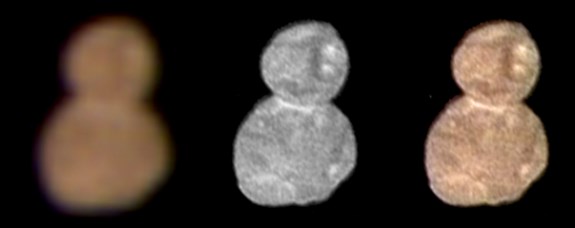Taken at a distance of 137,000 kilometers, this is the first detailed photo of one of the most distant objects ever explored. Ultima Thule consists of two components, which collided during the formation of the solar system. The object is basically a look back in time, as it's one of the sort of objects that served as building blocks for the formation of planets and moons.
"This flyby is a historic achievement," said New Horizons Principal Investigator Alan Stern of the Southwest Research Institute in Boulder, Colorado. "Never before has any spacecraft team tracked down such a small body at such high speed so far away in the abyss of space. New Horizons has set a new bar for state-of-the-art spacecraft navigation."
The new images — taken from as close as 17,000 miles (27,000 kilometers) on approach — revealed Ultima Thule as a "contact binary," consisting of two connected spheres. End to end, the world measures 19 miles (31 kilometers) in length. The team has dubbed the larger sphere "Ultima" (12 miles/19 kilometers across) and the smaller sphere "Thule" (9 miles/14 kilometers across).
The team says that the two spheres likely joined as early as 99 percent of the way back to the formation of the solar system, colliding no faster than two cars in a fender-bender.

Another interesting report is that China's Chang'e 4 spacecraft landed on the dark side of the moon. This makes China the first country to send a lander and a rover to the far side of the moon.
China's Chang'e-4 probe touched down on the far side of the moon Thursday, becoming the first spacecraft soft-landing on the moon's uncharted side never visible from Earth. The probe, comprising a lander and a rover, landed at the preselected landing area on the far side of the moon at 10:26 a.m. Beijing Time (0226 GMT), the China National Space Administration announced.